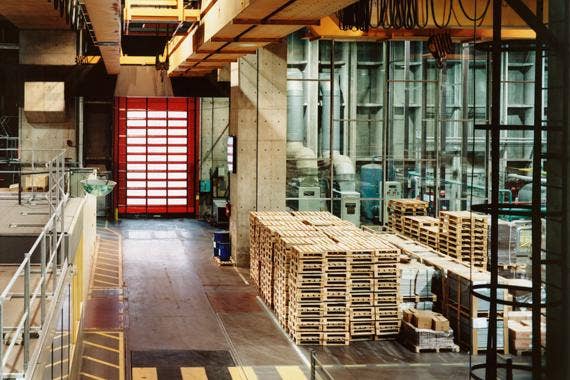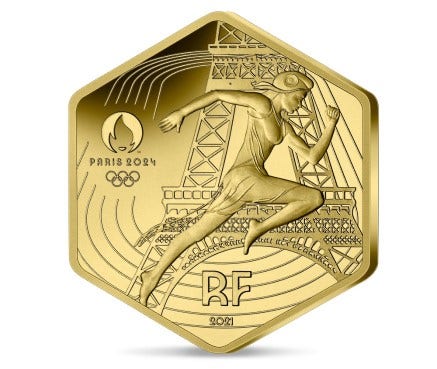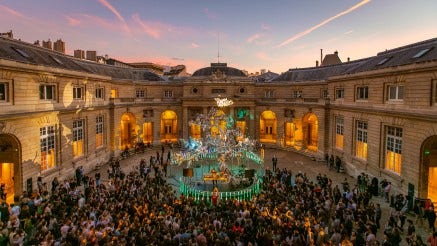The architecture of Monnaie de Paris
Paris, front facade: a neoclassical style
Under Louis XV, royal power seized the huge and prestigious land of the former Hôtel de Conti and decided to install its mint there – royal prerogative par excellence.
The architect Jacques-Denis Antoine (1733-1801) was chosen to manage the works. Antoine constructed a sumptuous building, a veritable palace arranged around courtyards but preserving the functionality of a modern and rational manufacturing site. The foundation works began at the end of 1769 and the mint was officially installed on the quai de Conti on 20 December 1775.
The building has kept its original vocation until this day, which is exceedingly rare. The first factory in Paris when it was built, Monnaie de Paris is today the last in activity in Paris.

A prestigious ensemble
Antoine allied erudite references with great quality of execution.
He designed the building in the neo-classical style: columns, pediments, harmonious proportions and a rich sculptural programme..

A total masterpiece: the decoration of the palace
The architect, Jacques-Denis Antoine, designed his building in the finest detail. He even designed the furniture of the Salon d’Honneur.
Antoine surrounded himself with a team including the most gifted artists of the time. These included the sculptors Jean-Baptiste Pigalle, Jean-Denis Antoine, brother of the architect, and the painter Jean-Jacques Forty.
Monnaie de Paris was the first great construction in Paris under the reign of Louis XV.

The rational manufacturing site
Beyond the palace, the manufacturing site: instead of being traditionally arranged around a chapel, the building was constructed using the rational production process of the time and articulated around the Grand Mint, where the coins were struck.
The various workshops have reinvented themselves until today, following the industrial evolutions.

Before Versailles, the petit Hôtel de Conti
Hidden inside Monnaie de Paris is a gem of the 17th century: a town house built by Jules Hardouin-Mansart when he was only 23 years old. The petit Hôtel de Conti, known as Aile Mansart is his first known work.
When Antoine designed the Hôtel des Monnaies, this masterpiece of the Primary Architect of Louis XIV is preserved and rapidly espouses an industrial vocation.

Pessac, tails side: a modernist style
In the 1970s, with the quai de Conti mint no longer able to meet the needs of the State and making impossible the development of the industrial unit, the president of the Council of Ministers approved the construction of a new factory.
It would be functional, rational and powerful, in line with the Modern movement inherited from Bauhaus. A new breakdown which is still current today was thus decided upon: the provincial factory will be reserved for industrial minting while Paris conserved the artistic productions.

Looking good at fifty
It was Pessac, near Bordeaux, which was chosen due to the road, air and sea transport facilities. The Salier-Courtois-Lajus-Fouquet (follower of Le Corbusier) workshop began to be built in 1972.
After almost 200 years, the minting of common coins left the quai de Conti for Pessac, and was inaugurated in September 1973. After 50 years of operation, the Pessac factory still remains at the cutting edge of technology and research.

Pessac, it's mathematical
To meet the minting needs, a factory covering 13,300 m2 was built. Th industrial section, the research and analysis laboratories and the offices are housed over a total area of 20,400 m2.
No less than 26,000 m3 of concrete, 125,000 m2 of casing and 1,200 tonnes of steel were necessary. The noble and imposing allure of the building consecrated the grand State architecture of the time.
Explore all the faces of Monnaie de Paris
-
-
Break into our plant in Pessac
Pessac plant strikes approximately 1 billion circulating coins at Pessac, half of it is for the export market
-
Online shop
Discover all our products
Buy online our latest collection ! Secured payment and fast shipping
-
Learn more about our craftmanhip
Thanks to their state-of-the-art know-how, our creative craftsmen shape precious ores, engrave style and time in metal and manufacture medals, awards, decorations...
-
Learn about our thousand year history
Monnaie de Paris is France's longest standing institution and one of the oldest enterprise in the world
-








_19th_century.jpg)
